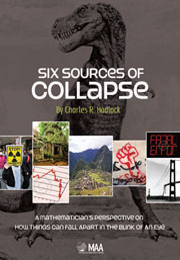 Six Sources of Collapse
Six Sources of Collapse Book contents
- Frontmatter
- Preface
- Acknowledgements
- Contents
- 1 Introduction
- 2 Predicting Unpredictable Events
- 3 Group Behavior: Crowds, Herds, and Video Games
- 4 Evolution and Collapse: Game Playing in a Changing World
- 5 Instability, Oscillation, and Feedback
- 6 Nonlinearity: Invitation to Chaos and Catastrophe
- 7 It's All About Networks
- 8 Putting It All Together: Looking at Collapse Phenomena in “6-D”
- References
- Index
- About the Author
6 - Nonlinearity: Invitation to Chaos and Catastrophe
- Frontmatter
- Preface
- Acknowledgements
- Contents
- 1 Introduction
- 2 Predicting Unpredictable Events
- 3 Group Behavior: Crowds, Herds, and Video Games
- 4 Evolution and Collapse: Game Playing in a Changing World
- 5 Instability, Oscillation, and Feedback
- 6 Nonlinearity: Invitation to Chaos and Catastrophe
- 7 It's All About Networks
- 8 Putting It All Together: Looking at Collapse Phenomena in “6-D”
- References
- Index
- About the Author
Summary
The elephant's toenail
I remember a silly gimmick of one of my high school teachers back in Brooklyn, and the fact that I remember it so vividly after about fifty years makes me think it's worth retelling. I'm finally beginning to really appreciate it.
He showed us a huge blown-up dirty white picture of something that had no strong distinguishing features, a bit of nondescript texture, and that extended right to the boundary of the photo frame. Then he asked us to guess what it was that we were looking at. The whole class really got into this exercise with an impressive degree of creativity and energy. Everyone wanted to be the person with the correct guess. The teacher was being bombarded with suggestions. Hands were waving in the air. The suggestions probably included things like a garage floor, a subway platform, old kitchen linoleum, or maybe even the surface of the moon.
But no one got it. After all, who would have guessed that we were looking at an elephant's toenail? No one was thinking that this was the image of something such that if we had access to just a small additional amount of the photo field, everything would change drastically from what we were thinking about. Built into our way of thinking was that this image should extend off to the sides in a fashion similar to the part we could see and thus that there was a certain homogeneity to the structure of the object.
- Type
- Chapter
- Information
- Six Sources of CollapseA Mathematician's Perspective on How Things Can Fall Apart in the Blink of an Eye, pp. 121 - 144Publisher: Mathematical Association of AmericaPrint publication year: 2012


